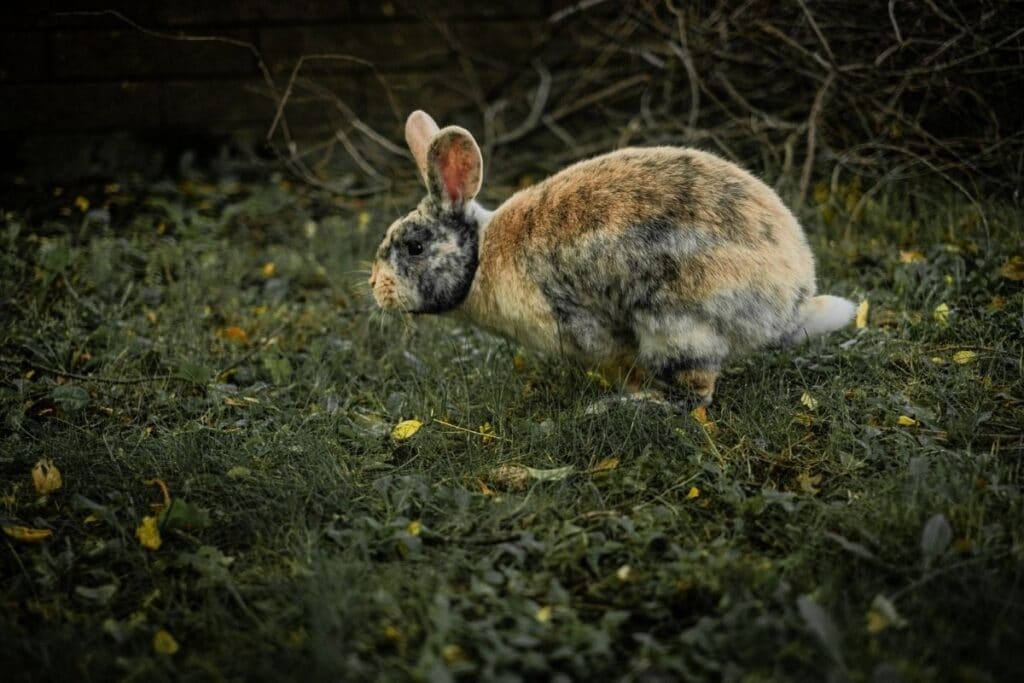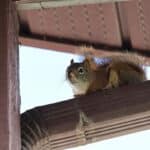Rabbits can be a big problem for homeowners. They can damage gardens and landscaping, and they can also be a health hazard since they can carry diseases. In this post, we’ll discuss some ways to get rid of rabbits from your yard.
Truth be told, there is something endearing about the fluffy and chubby stature of a wild rabbit. The way they hop along, sniffing for goodies and nibbling on grasses, is pleasant to watch.
However, not all rabbits mind their own business. Some cannot help themselves from digging up the lawn, ransacking tender buds and seedlings, and foraging on fruits, vegetables and woody plants.
In some areas of the world, wild rabbits are bold and opportunistic. They consider your yard and garden as their personal grocery store. In some cases, it might be. Having rabbits around is a sign that your yard is a valuable resource to them. However, their cuteness quickly dissolves when they move on from the grasses and bushy foliage and start ruining fruits and vegetables.
If this sounds like what you are experiencing, and if you need to get rid of rabbits in the garden, keep reading. Below we will talk about some of the best ways to control the rabbit problem around your home in the most effective and humane manner possible.
Understanding Rabbits
Rabbits are long-eared mammals that come from the family Leporidae. Rabbits and hares are routinely used interchangeably. However, they are two different types of animals. Rabbits are different from hares because they tend to be smaller, have shorter ears, and prefer different habitats. Baby rabbits are born hairless and with closed eyes after a gestation period of about 30 days.
The long ears of rabbits are evolutionary adaptations that help detect predators. They also have long and powerful hind legs that help them jump and run up to 50 miles per hour. Rabbits have five digits on each paw and move around in a fashion called digitigrade locomotion.
Many rabbits dig holes and develop tunnel systems called warrens. Nonburrowing rabbits make nests in dense vegetation. Locations such as parks, prairies, garden beds, and overgrown fields all serve as valuable habitats for rabbits. Rabbits are generally nocturnal but do spend time outside during the day. Their diets consist of plant material and the fruits and veggies they can find in your garden.
Ideal Rabbit Habitat
For the most part, rabbits have all they need in the wild. However, as rabbit populations grow and as our homes move closer to wild spaces, rabbits spend more and more time around our homes. Rabbits are attracted to our yards as they search for three vital things:
- Food– rabbits are constantly foraging for food. They love the various tender greens we have in our flower and vegetable gardens. They even feed on woodier plants as well. They especially love the buds and twigs on younger plants.
- Water- when water is hard to come by in the wild, rabbits are drawn to your yard. Pools, ponds, and birdbaths all serve as valuable water sources. Finding non-frozen water in your yard is especially important during the winter months.
- Shelter– rabbits may be using the foliage in your yard for protection. Weedy and tall grasses make for ideal nesting areas and evergreen shrubs. They may also be burrowing in the lawn and underneath the back patio or shed. Rabbits also utilize brush piles, wood, and other debris for shelter.

Getting Rid of Rabbits Outside
Sometimes rabbits use the outdoor spaces around our homes to forage for food and water. They enjoy the wild grasses that grow and the shrubs that can shelter them from predators. Every so often, they cross the line and help themselves to plants we’ve deemed as off-limits.
Keep Up With Rabbit Repellent
Rabbits have an incredibly impressive sense of smell. Scents play an important role in communication amongst rabbits, more so than sound. So you can rely on their sense of smell to keep rabbits away by applying rabbit repellent.
Rabbit repellents are solutions (and sometimes granulated powder) that you can spray or sprinkle to fend off rabbits. Repellents utilize ingredients that have intense aromas that rabbits find to be unbearable. The repellents effectively create an invisible odor barrier that repel rabbits want to turn around and head in the other direction.
You can use natural rabbit repellent to protect certain plants and areas of your yard. Routine application of repellents is essential to keep up the intensity of the scent. Reapplying after rainfall and watering is also very important.
Maintain a Tidy Yard and Garden
Rabbits tend to come around more often when they observe that your yard or garden has valuable opportunities for them regarding food, water, and shelter. Maintaining a tidy yard and garden is beneficial for sending the message to rabbits that your home is not for them.
Regular maintenance of the lawn and the tall grasses around the perimeter of your property is an excellent place to start. Removal of tall grass, brush and debris piles is also crucial because rabbits see those as shelter.
Timely harvesting of fruits and vegetables will ensure rabbits don’t score the first bite. The removal of excess plant material to a separate area will keep rabbits away from the garden.
How to Get Rid of Baby Rabbits
The average litter size for pregnant female rabbits is seven. However, some females can have up to 15 babies. Baby rabbits are weaned off the mother’s milk in about a month.
Shortly after that, they are left on their own. At this point, after they leave the nest, they may find their way into your yard and you will have a rabbit population problem.
What To Do If You Find a Nest of Baby Rabbits
If you find a nest of baby rabbits around your yard, you will be faced with a decision. If you don’t mind that the rabbits are there, it’s best not to touch the baby rabbits and leave them alone.
Touching or handling the babies will mark them with your scent, which may result in the babies being rejected by the mother.
If you want to get rid of the rabbits, we suggest calling a pest control professional or animal control. They will be able to remove the baby rabbits safely. Depending on your local area, the baby rabbits will be relocated back into the wild or brought to the humane society for proper care.
Removing Rabbits Naturally
Do you have a problem with rabbits eating your garden plants? Here are some tips on how to get rid of them in an Eco-friendly way.
Let Your Pets Play in the Yard
Rabbits consider pet dogs and cats to be predators. If they suspect that your pet is in the area, they will go somewhere safer.
So one of the most straightforward measures you can take is to let your pets get plenty of time outside. The scents they leave behind will mark the territory as unsafe and incentivize the rabbits to go away.
Motion-Activated Rabbit Deterrents
If you want to get rid of bunnies naturally, we recommend using motion-activated deterrents. One example is a motion-activated sprinkler. You can position the bunny deterrent around the garden so that when rabbits come for a snack, their movement triggers the sprinkler. The sudden movement and noise from the rabbit deterrent will scare off the skittish rabbit and water the plants.
Another option is a motion-activated ultrasonic repeller. These devices emit an ultrasonic sound that is inaudible for humans but bothersome to rabbits and other animals. The sound does not hurt the rabbits but merely scares them away.
Tips to Get Rid of Rabbits Without Killing Them
Not all tactics for removing rabbits involve killing them. Some of the most effective strategies are non-lethal to deal with rabbit infestation problem.
Install a Fence
Installing a robust fence around the perimeter of your yard or garden that prevents jumping and burrowing is an effective strategy to take. One of our favorite fencing designs utilized recycled wooden pallets and chicken wire to create a functional fence that also looked great.
If an entire fence is too much, you may also just consider putting a barrier around particular plants. We recommend protecting freshly planted seedlings and maturing plants because they tend to be easy pickings for rummaging rabbits.
Stopping Rabbits Without Harming Dogs
Sometimes the measures we take to control pests like rodents and rabbits are not the safest for our pets. For example, if you set poison out for rats or mice, your dog may become curious about the new object and scent. However, there are other ways to get rid of rabbits without harming the dog.
Rabbits are prey to larger animals such as owls, hawks, eagles, bobcats, and foxes. You can position plastic decoy predators around your yard to scare rabbits away. The rabbit will see the decoy and decide not to come around.
Remember, if you do use decoy predators, make sure to adjust the predator’s location from time to time. This will prevent the rabbits from catching on to the fact that the predator is not a live threat.
Rabbits Under a Concrete Porch
Some rabbits like to burrow. They create networks of tunnels called warrens where they live and mate with other rabbits. Because of this, it’s not uncommon to find a rabbit warren underneath your porch. If this is happening in your yard, it may be best to call a professional for help.
Draw the Rabbits Out
If you suspect that rabbits have made a home underneath your deck, the first thing you will need to do is draw the rabbits out. You can set bait for the rabbits to incentivize them to come out. Once out, the rabbits will need to be trapped and relocated.
Seal off the Porch
Once you’ve removed the rabbits from underneath the porch, you will need to seal off the previous entrance. To prevent ore rabbits from burrowing in the future, we recommend lining the exterior of your porch with buried chicken wire fence.
Removing Rabbits Under the Deck
Rabbits look for opportunities for shelter wherever they go. If they can gain access to the nooks and crannies underneath your deck, then they will use the area to make a nest.
The spaces underneath decks, patios, and porches are all valuable in the eyes of rabbits. That is why it’s important to remove the temptation to use these spaces before it becomes a problem. The most effective way to do this is to put up a barrier.
You can seal off the undersides of your deck using a variety of materials. The most affordable option is mesh chicken wire. When installing the chicken wire, bury the bottom side at least 6 inches into the soil to prevent burrowing.
If you are not thrilled about the aesthetic of chicken wire, you may consider closing entrances using wood lattice. As a bonus, the lattice can then be used as a trellis for climbing plants and vines.
How to Stop Rabbits from Coming to Your Yard
There are all sorts of ways to keep rabbits out of your yard. Many of which we have talked about above. Which strategies you employ will depend on the severity of the problem, the specifics of your yard, and the tactics that best fit your disposition towards the problem.
If the problem is particularly severe, you will need to consider a strategy that involves heavier hitting tactics. You may also need to combine multiple preventative measurements to get the desired result.
On the other hand, if the problem is not quite severe, you may just need to focus on the particular plants falling victim to the rabbits. Whatever the case may be, patience and consistency will be essential for your success to prevent rabbits from destroying your vegetable garden.
Get Rid of Rabbits for Good
Rabbits are a part of nature. If you live in rabbit country, you may never be able to get rid of these bunnies completely and permanently. You can control the frequency in which rabbits visit and the areas of your property they can access by growing some rabbit proof plants.
Of course, always check the laws in the area where you live (both at the federal, state, and local level). Certain areas have regulations in place about what you can and cannot do to control rabbits on your property.
It’s all about consistency. Every year, when the spring weather begins to roll around, you’ve got to work protecting your plants with barriers, applying your repellent, and removing opportunities for shelter. With time, the opportunistic rabbits will learn that your property is not as valuable to them as before, and they’ll choose to move onto green pasture.
FAQs
What smell keeps rabbits away?
Strong-smelling substances such as garlic, onion, peppermint, or vinegar are often used to deter rabbits from gardens or flower beds.
What is the best homemade rabbit repellent?
One effective homemade rabbit repellent is a mixture of crushed garlic cloves, cayenne pepper, and water. Simply combine these ingredients, strain the mixture, and spray it on plants or areas where rabbits frequent. Additionally, planting rabbit-resistant plants or using physical barriers like fences can help deter rabbits from entering certain areas.
How do you get rid of rabbits without killing them?
To get rid of rabbits without killing them, consider implementing humane deterrents such as installing fencing with small openings at the bottom to prevent them from burrowing underneath, using motion-activated sprinklers or lights to scare them away, or applying natural repellents like predator urine or strong-smelling substances around the perimeter of your garden. Additionally, providing alternative food sources or habitats away from your garden can help encourage rabbits to seek shelter elsewhere.
*image by Cavan&Wirestock/depositphotos







